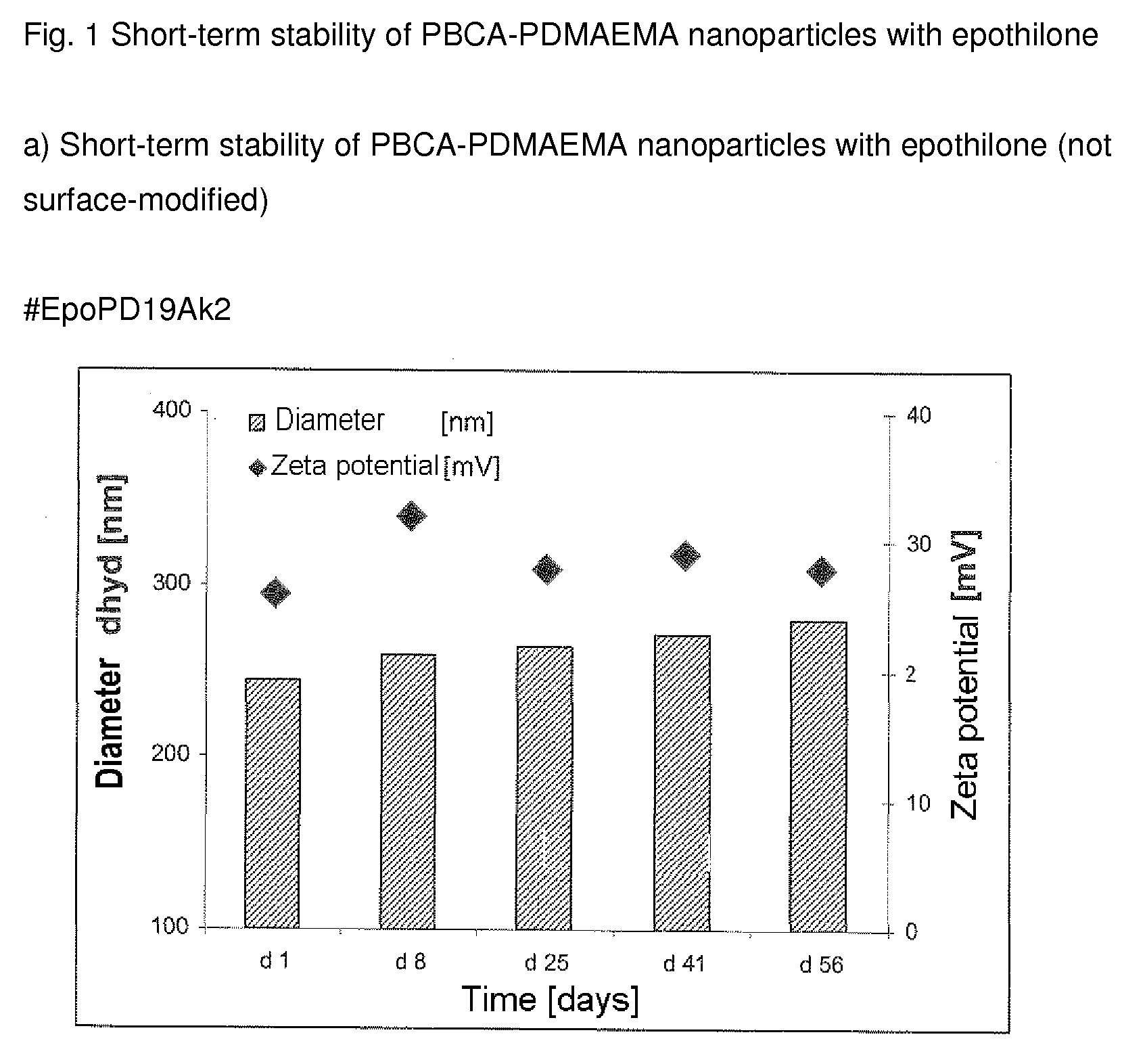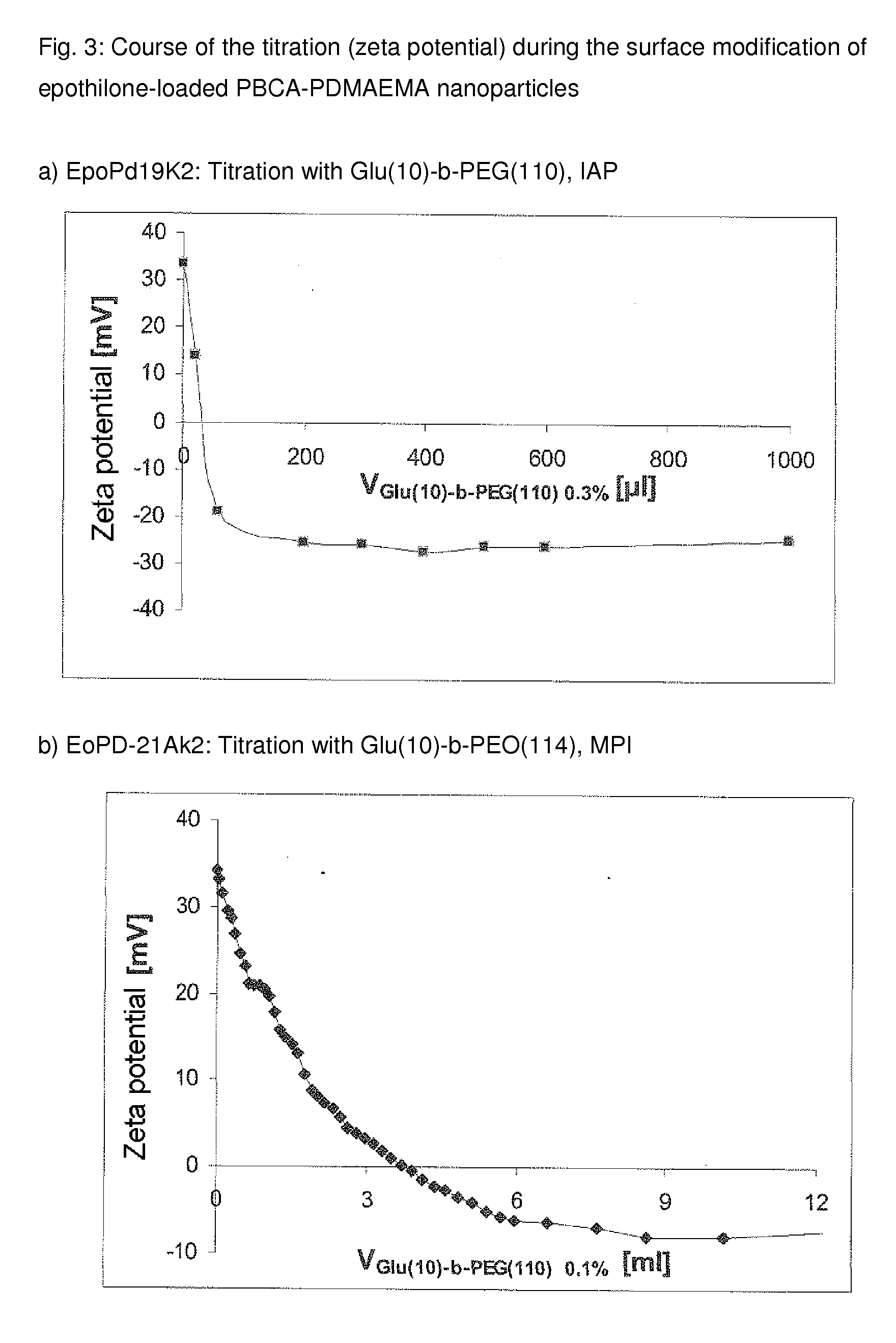Functionalized, solid polymer nanoparticles comprising epothilones
a polymer nanoparticle and functional technology, applied in the field of polymer nanoparticles with cationic surface potential, can solve the problems of cell possesses very effective, all the body's rapidly dividing cells, including tumor cells, are damaged, and the death of tumor cells, etc., to achieve good solubility in water, less time-consuming, and cost-effective
- Summary
- Abstract
- Description
- Claims
- Application Information
AI Technical Summary
Benefits of technology
Problems solved by technology
Method used
Image
Examples
example 1
Production of PBCA by Anionic Polymerization
[0272]Sicomet 6000 is used for PBCA production by anionic polymerization of butyl cyanoacrylate (BCA). The polymerization process is carried out by slow, permanent dropwise addition of a total of 2.5% [w / v] BCA to a 1% [w / v] Triton X-100 solution in an acidic solution (pH 1.5-pH 2.5, ideally pH 2.2). The pH value is adjusted beforehand by means of a 0.1N HCl solution. The resultant dispersion is stirred at a constant 450 rev / min while cooling on an ice bath (approx. 4° C.) for 4 hours. Then larger agglomerates are removed by filtration through a pleated paper filter. By adding methanol (or other suitable alcohols such as ethanol), the BCA polymerized to PBCA is precipitated and the filter residue obtained from it is washed several times with purified water (MilliQ system). After drying the PBCA filter residue in a drying cabinet at 40° C. for 24 h, an average molecular weight is determined by GPC (Mn˜2000 Da). Polysterol standards are used...
example 2
Preparation of Epothilone-Loaded PBCA-P(DMAEMA) Nanoparticles by Nanoprecipitation
a) Preparation of the Polymer / Substance Mixture (=Mixture 1) and the Surfactant Solution
[0274]30 ml of a 4% strength solution of PBCA in acetone (w / v), 3 ml of a 4% strength PDMAEMA solution in acetone (w / v) and 3 ml of a solution of epothilone in acetone (concentration about 60 mg / ml) are pipetted into a screw-top vial (50 ml) and, after the vial has been closed with a screw-on lid, mixed well with shaking (=mixture 1). The PBCA used is prepared according to Example 1. In each case 10 ml of a 1% strength Synperonic T707 solution (w / v) are initially charged in a 20 ml screw-top glass with magnetic stirrer bead.
b) Preparation of the Particle Dispersion by Nanoprecipitation
[0275]At a high stirrer speed (600 rpm), 1.2 ml of mixture 1 are rapidly pipetted into 10 ml of the surfactant solution. After 2-3 h, at a lower stirrer setting (100 rpm), the remaining acetone is evaporated in a fume cupboard for a fu...
example 3
Preparation of Epothilone-Loaded PBCA-P(DMAPMAM) Nanoparticles by Nanoprecipitation
a) Preparation of the Polymer / Substance Mixture (=Mixture 1) and the Surfactant Solution
[0277]30 ml of a 4% strength solution of PBCA in acetone (w / v), 3 ml of a 4% strength PDMAPMAM solution in acetone (w / v) and 3 ml of a solution of epothilone in acetone (concentration about 60 mg / ml) are pipetted into a screw-top vial (50 ml) and, after the vial has been closed with a screw-on lid, mixed well with shaking (=mixture 1). The PBCA used is prepared according to Example 1. In each case 10 ml of a 1% strength Synperonic T707 solution (w / v) are initially charged in a 20 ml screw-top glass with magnetic stirrer bead.
b) Preparation of the particle dispersion by nanoprecipitation
[0278]At a high stirrer speed (600 rpm), 1.2 ml of mixture 1 are rapidly pipetted into 10 ml of the surfactant solution. After 2-3 h, at a lower stirrer setting (100 rpm), the remaining acetone is evaporated in a fume cupboard for a ...
PUM
| Property | Measurement | Unit |
|---|---|---|
| Size | aaaaa | aaaaa |
| Electrical conductance | aaaaa | aaaaa |
| Solubility (mass) | aaaaa | aaaaa |
Abstract
Description
Claims
Application Information
 Login to View More
Login to View More - R&D
- Intellectual Property
- Life Sciences
- Materials
- Tech Scout
- Unparalleled Data Quality
- Higher Quality Content
- 60% Fewer Hallucinations
Browse by: Latest US Patents, China's latest patents, Technical Efficacy Thesaurus, Application Domain, Technology Topic, Popular Technical Reports.
© 2025 PatSnap. All rights reserved.Legal|Privacy policy|Modern Slavery Act Transparency Statement|Sitemap|About US| Contact US: help@patsnap.com



